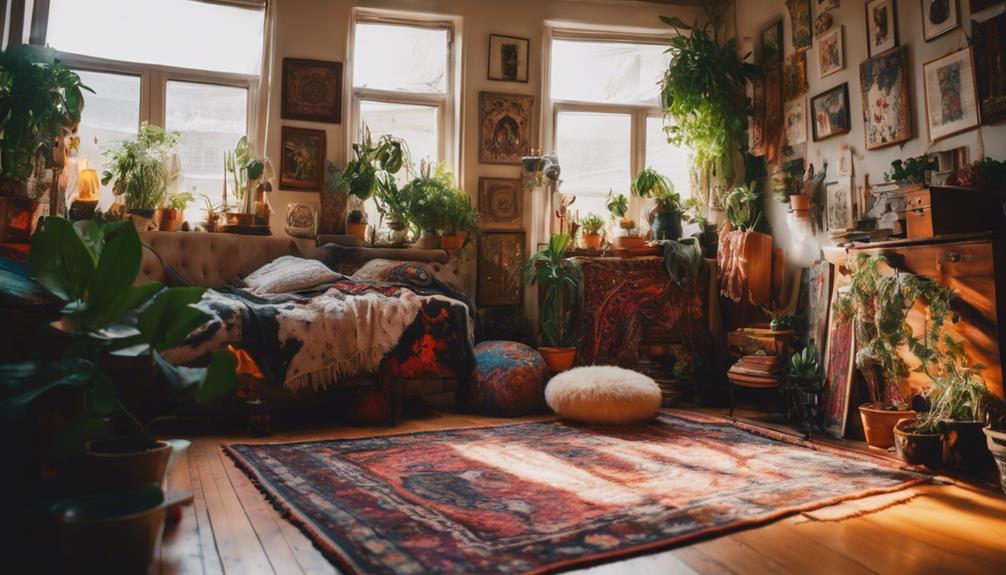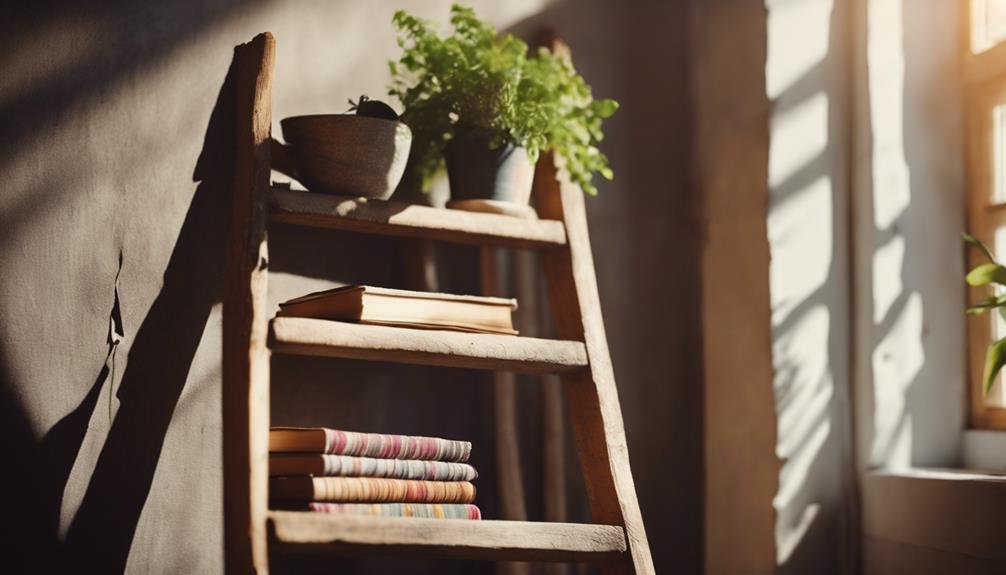Indie room decor is all about showcasing your personality with vibrant colors, unique textures, and eclectic furnishings. Think of mixing bold hues like pale yellows or fun oranges to create a lively atmosphere. Vintage pieces, like a wooden coffee table or leather armchair, add character. Incorporate cozy lighting with Edison bulbs or vintage string lights to enhance warmth. Don't forget decorative elements like hand-painted plates or vintage band posters to tell your story. Finally, rich textures from pillows and rugs create comfort. You'll discover even more creative ideas and tips to elevate your space and impress everyone.
Key Elements
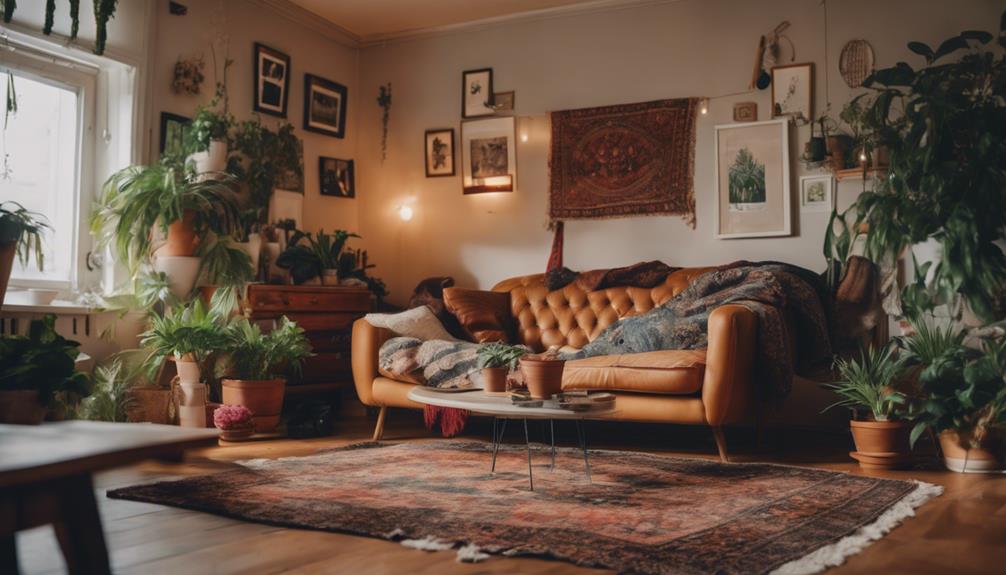
When creating your indie room decor, the color scheme sets the tone, so choose vibrant hues that reflect your personality.
Materials and textures play a vital role, as mixing soft fabrics with hard surfaces adds depth and interest.
Don't forget to incorporate unique elements that tell your story, making your space truly one-of-a-kind.
Color Scheme
The indie aesthetic's vibrant color scheme encourages you to embrace bold shades like pale yellows, greens, and fun oranges, creating an atmosphere that's uniquely yours. Immerse yourself in a world of psychedelic hues that can transform your space into a visual delight. Mixing and matching these vibrant colors allows you to reflect your personal taste, making the room a true extension of your personality.
Don't shy away from using pastels for a softer, whimsical touch, or opting for monochromatic schemes to achieve a modern look. The indie aesthetics offer flexibility, letting you choose what resonates most with you. Incorporating neon splashes alongside earthy tones can create a striking contrast, enhancing the ambiance and energy of your room.
Whether you're going for a cheerful vibe or something more eclectic, vibrant colors are pivotal in crafting a space that feels inspiring. Remember, the key is to experiment and have fun with your choices. Each splash of color you choose contributes to a unique narrative, making your room an enchanting reflection of who you are.
Materials
Incorporating a mix of eclectic textures and materials can transform your indie space into a vibrant expression of your personality. Start by blending various materials like wood, metal, ceramics, and textiles to create layers that captivate the eye. Thrifted finds are a treasure trove for unique pieces—look for vintage furniture or quirky accessories at local thrift stores and flea markets. These items not only add character but also infuse a sense of history into your decor.
Don't forget to include natural elements. Integrating plants and materials such as stone or wicker helps you connect with nature while improving the ambiance of your space. The presence of greenery can uplift your room and enhance air quality, making it a healthier environment.
Lastly, embrace the DIY projects that allow you to tell your story. Refurbish or upcycle old furniture and decor items to create one-of-a-kind pieces that reflect your personal style. Each DIY creation adds a layer of individuality to your space, showcasing your creativity and resourcefulness.
Textures
Embracing a variety of textures is essential for creating a rich and inviting indie room that reflects your unique style. Textures add depth and interest, transforming your space into a tactile experience. Think soft velvet cushions, rugged burlap throws, and smooth ceramics that invite touch. Layering these elements fosters a cozy atmosphere that's perfect for unwinding after a long day.
Incorporate knitted throws or woven wall hangings to enhance that inviting feel. Don't shy away from vintage furniture, as it often brings unique textures like aged leather or distressed wood, further enriching your room's character and story.
Mixing materials is key—combine metal accents with wooden furniture to achieve an eclectic look that showcases your individuality and creativity.
To maintain visual dynamism, layer textures through throw pillows, blankets, and rugs. This approach not only adds comfort but also encourages relaxation, making your indie room a space where you and your guests feel at home.
Essential Fixtures and Furniture
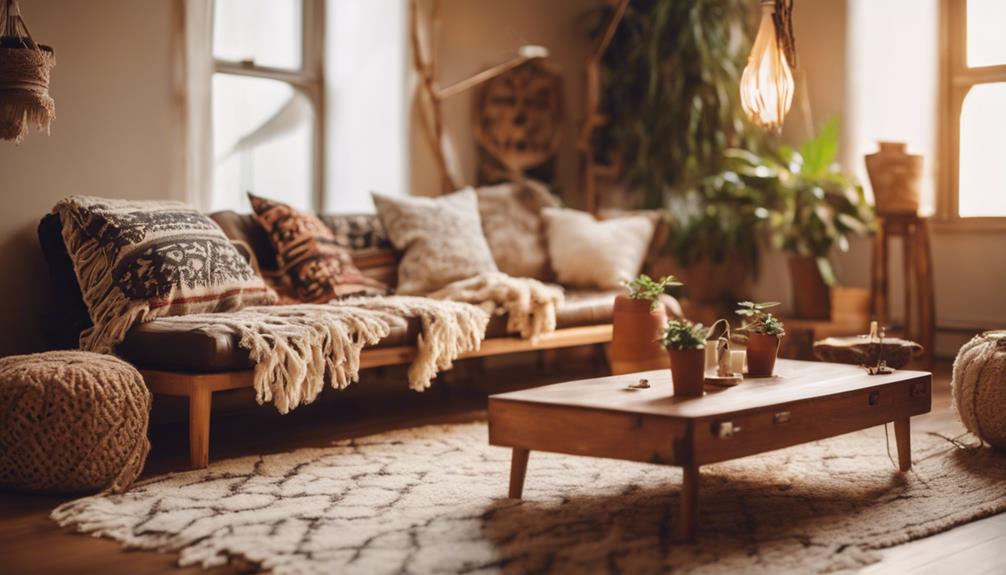
When it comes to essential fixtures and furniture, vintage pieces can truly elevate your indie aesthetic.
A vintage wooden coffee table, a stylish record player stand, and a cozy leather armchair not only add character but also create a welcoming vibe in your space.
Let's explore how these choices bring personality and functionality to your room.
Vintage Wooden Coffee Table
A vintage wooden coffee table can transform your indie aesthetic room by serving as a striking focal point that blends character with functionality. These tables often showcase unique craftsmanship, adding warmth and history to your space while being sturdy enough for coffee breaks or creative projects.
When you choose a vintage wooden coffee table, seek out distinctive features like distressed finishes, interesting grain patterns, or retro designs that enhance your indie aesthetic room decor. Thrift stores and flea markets are fantastic places to hunt for these affordable gems, letting you incorporate sustainable practices into your decor while finding one-of-a-kind pieces.
To make the table truly yours, consider adding personal touches. Pair it with colorful coasters, eclectic books, or potted plants that reflect your personality and style. This not only elevates the table's aesthetic appeal but also creates a versatile space that invites conversation and creativity.
Vintage Record Player Stand
Transform your indie aesthetic room with a vintage record player stand that not only showcases your vinyl collection but also adds a touch of nostalgia to your decor.
These stands serve as stylish fixtures, enhancing your space while providing a dedicated area for your record player and albums. Made from solid wood, many vintage stands offer durability and a warm, inviting feel that beautifully complements your eclectic decor.
When selecting a vintage record player stand, look for options that include additional storage, like shelves or drawers, to keep your records organized and easily accessible. This not only maintains a clean appearance but also helps you display your unique personality through your music collection.
Positioning your stand thoughtfully can create a focal point in the room, sparking conversations with guests about your shared musical tastes. Pair it with wall decor that resonates with your indie aesthetic style, and you'll create an inviting atmosphere that reflects who you are.
Vintage Leather Armchair
Elevate your indie aesthetic room with a vintage leather armchair that effortlessly blends sophistication and character. These chairs often showcase rich patinas and unique wear, adding a narrative element to your space. You'll find a variety of styles, from mid-century modern to classic Chesterfield, allowing you to perfectly complement your eclectic decor.
Investing in a high-quality vintage leather armchair not only enhances visual appeal but also guarantees comfort and durability for years to come. Thrifting or shopping at second-hand stores can lead you to one-of-a-kind pieces that are often more affordable than new furniture, all while promoting sustainable practices.
To make your vintage leather armchair a cozy focal point, consider pairing it with colorful throw pillows or a quirky blanket. This combination bridges classic style with modern indie flair, creating an inviting atmosphere. Whether you're curling up with a book or entertaining friends, this armchair will impress everyone who enters your space.
Lighting Ideas
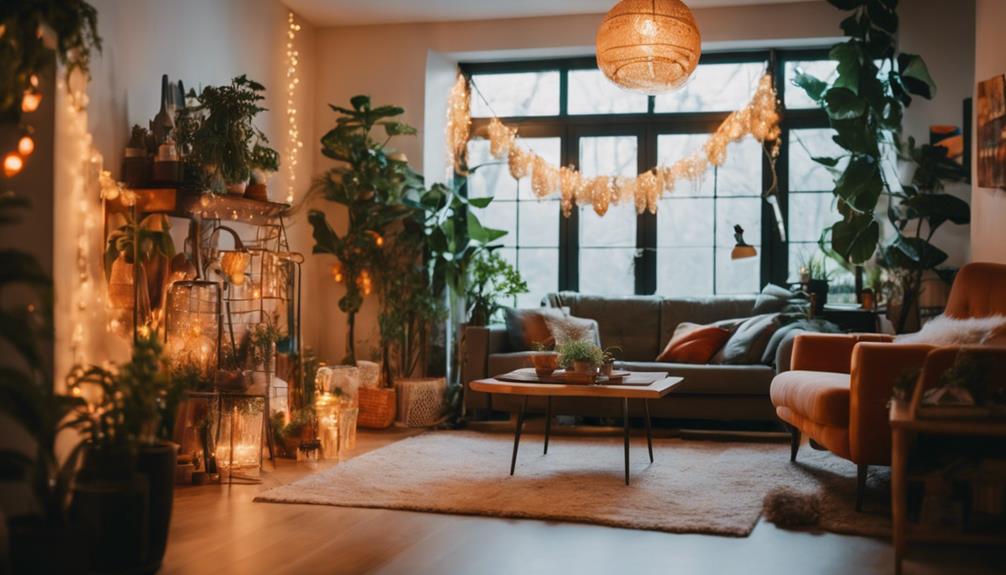
When it comes to lighting, you can really set the mood with a few key choices.
Think about hanging Edison bulb fixtures for that vintage charm, or string lights with warm, inviting bulbs to enhance your indie vibe.
Colorful neon wall lamps and vintage table lamps can also add a unique touch, making your space feel both cozy and creative.
Hanging Edison Bulb Fixtures
Hanging Edison bulb fixtures effortlessly blend vintage charm with modern design, making them a perfect choice for enhancing your indie aesthetic room.
These fixtures not only add a nostalgic touch but also create a warm and inviting atmosphere that's ideal for cozy reading nooks or artistic spaces. With their exposed filament bulbs, they emit a glow that transforms your room into a haven of creativity.
You can find hanging Edison bulb fixtures in various styles, including industrial and bohemian, allowing you to customize your decor items to fit your personal taste.
Whether you prefer sleek, minimalist designs or more intricate styles, there's an option for everyone. Plus, incorporating dimmer switches with these fixtures lets you adjust the lighting to craft the perfect mood, whether you're unwinding or getting inspired.
Another bonus is that many Edison bulbs use LED technology, making them energy-efficient while maintaining their fashionable appeal.
By integrating hanging Edison bulb fixtures into your indie rooms, you not only enhance the aesthetic but also create a unique ambiance that impresses everyone who enters.
String Lights With Vintage Bulbs
String lights with vintage bulbs instantly transform any space into a cozy retreat, infusing it with warmth and nostalgic charm. These lights not only enhance the indie aesthetic of your room but also create a welcoming atmosphere perfect for gatherings or quiet evenings. With exposed filaments that harken back to retro designs, vintage string lights add a unique touch that elevates your decor.
You can drape these string lights over furniture, hang them on walls, or arrange them around windows to add depth and character to your space. They come in various lengths and styles, making it easy to find the perfect fit for your room. Plus, with energy-efficient LED vintage bulbs, you get that beautiful glow without worrying about high electricity bills.
Incorporating string lights with vintage bulbs into your decor serves as more than just functional lighting; it acts as a striking decorative element that complements eclectic and artistic themes.
Colorful Neon Wall Lamps
Colorful neon wall lamps bring a vibrant touch to your space, instantly energizing the atmosphere with their eclectic glow. These lamps are a signature element of the indie aesthetic, allowing you to reflect your unique style while enhancing your home decor. Available in various shapes and sizes, colorful neon wall lamps can complement everything from vintage posters to lush plants, creating a harmonious blend of elements.
One of the best features of these lamps is their energy-efficient LED technology, which guarantees you can enjoy their stunning illumination without worrying about excessive energy consumption. You can mix and match different colors to create dynamic visual effects that make your room come alive.
Using neon wall lamps as focal points not only draws attention but also adds character to your space. Whether you opt for a quirky design or a minimalist shape, these lamps will elevate your decor while keeping the indie vibe intact.
Vintage Table Lamp With Shade
Incorporating a vintage table lamp with a shade can instantly elevate your indie room's aesthetic, adding a touch of nostalgia and warmth to your decor. These unique decor pieces not only provide functional lighting but also serve as focal points that reflect your personal style and artistic sensibilities.
When selecting a vintage table lamp, consider styles from the 60s and 70s, known for their bold colors and intriguing shapes that resonate with the indie aesthetic. A well-chosen lampshade can dramatically affect the ambiance, so opt for materials like fabric or glass to create a cozy, inviting atmosphere.
You can find stunning vintage table lamps at thrift stores or flea markets, where one-of-a-kind designs await discovery. These lamps embody individuality and sustainability, essential elements of the indie aesthetic. By choosing a vintage lamp, you're not just lighting your space; you're making a statement about your taste and values.
Decorative Elements
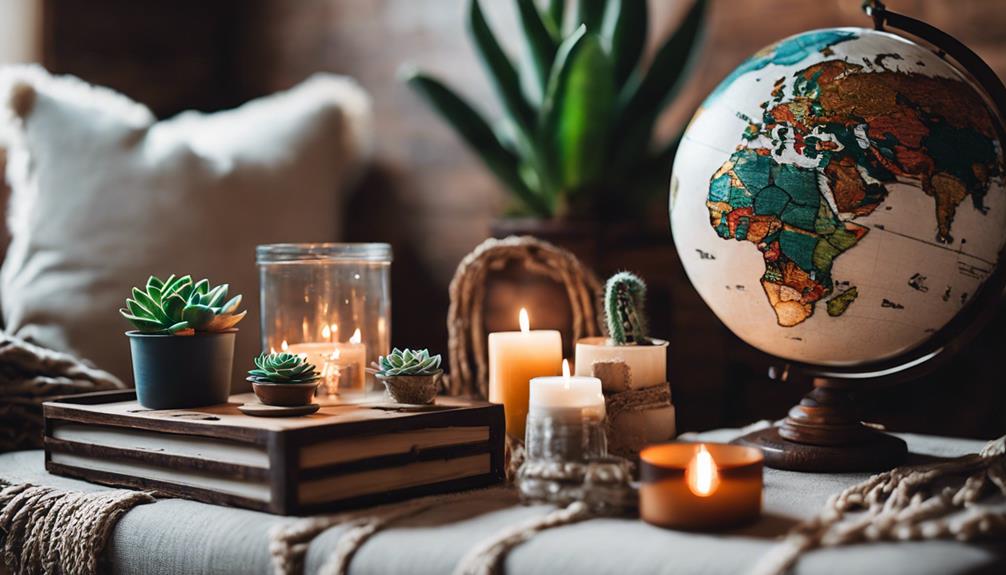
When it comes to enhancing your indie space, decorative elements like hand-painted ceramic wall plates and framed vintage band posters can make a huge impact.
Consider adding a vintage macrame wall hanging for texture and a touch of bohemian flair.
These unique pieces not only reflect your personality but also create a warm and inviting atmosphere.
Hand-Painted Ceramic Wall Plates
Hand-painted ceramic wall plates add a personal touch and vibrant flair to your space, perfectly capturing the essence of indie decor. These unique decorative elements aren't just visually appealing; they embody the spirit of creativity and individuality that defines the indie aesthetic. You can easily find hand-painted ceramic wall plates at local artisan shops or thrift stores, making them a sustainable choice that supports small businesses.
Displaying these plates can transform your walls into a stunning gallery, mixing various sizes and artistic designs for an eclectic look. The vibrant colors and whimsical patterns on the plates enhance visual interest, creating a focal point that invites conversation. By incorporating hand-painted ceramic wall plates into your decor, you showcase your appreciation for unique, handcrafted items that tell a story.
Whether you arrange them in a dynamic cluster or let a single plate shine on its own, these pieces will certainly impress everyone who enters your space. So, elevate your indie room decor with hand-painted ceramic wall plates, and let your walls reflect your personality and style!
Framed Vintage Band Posters
Framed vintage band posters add a nostalgic charm to your space, showcasing iconic musicians that resonate with the indie aesthetic. These eye-catching pieces often feature bold colors and striking graphics, injecting vibrancy and character into any room. You can easily find them at thrift stores, flea markets, or online vintage marketplaces, making them a fantastic option for personalizing your space.
Consider creating a gallery wall with your framed vintage band posters, mixing them with other art forms to enhance visual interest. This eclectic decor approach not only showcases your taste in music but also tells your personal story. You can choose frames that either complement or contrast with the artwork, allowing for a unique blend of styles that captures the essence of indie room decor.
Don't be afraid to experiment with arrangements, as the right layout can transform a simple wall into an enchanting focal point. By incorporating these posters into your decor, you'll not only celebrate your favorite artists but also create an inviting atmosphere that reflects your individuality and love for music.
Vintage Macrame Wall Hanging
Vintage macrame wall hangings bring a unique texture and bohemian vibe to your space, effortlessly elevating the indie aesthetic. Originating in the 1970s, these intricate pieces are crafted using knotting techniques with natural fibers like cotton, jute, or hemp. This not only enhances the earthy vibe in your decor but also adds a touch of artistry to any room.
You can use vintage macrame wall hangings as statement pieces that draw attention to empty walls, making them an ideal fit for a variety of color palettes—from soft pastels to vibrant hues. Whether you hang one above your bed, sofa, or in a cozy reading nook, these decorative elements provide both aesthetic appeal and a warm atmosphere.
Moreover, choosing vintage macrame is a sustainable choice, as many pieces are thrifted or upcycled, aligning perfectly with the indie ethos of valuing individuality and environmentally friendly decor. The versatility of macrame allows you to express your unique style while contributing to a more sustainable lifestyle.
Flooring
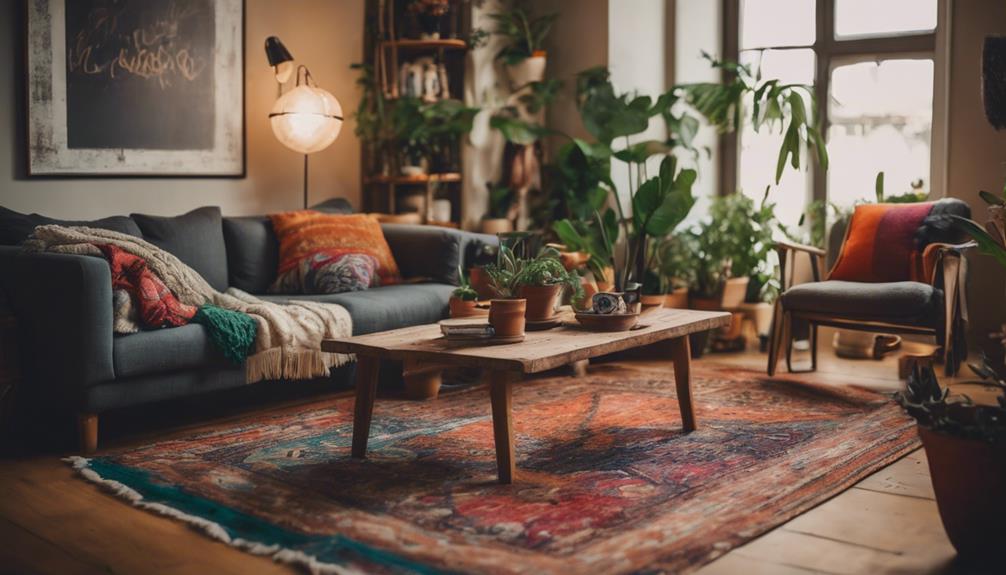
When it comes to flooring, you've got some great options to enhance your indie vibe.
Consider using reclaimed wood floorboards for a rustic touch, or layer a textured jute area rug for added warmth and character.
Cork flooring is another eco-friendly choice that not only feels cozy underfoot but also brings a unique element to your space.
Reclaimed Wood Floorboards
Reclaimed wood floorboards offer a unique, eco-friendly flooring solution that brings character and warmth to your indie-inspired space. Sourced from old buildings and barns, these floorboards not only reduce environmental impact but also add a distinctive charm to your home. Each plank carries a unique history, showcasing textures, colors, and patterns that perfectly align with the indie aesthetic's emphasis on individuality and eclecticism.
When you choose reclaimed wood floorboards, you're not just selecting a flooring option; you're investing in a story that enhances the aesthetic appeal of your room. Their rustic, vintage look creates an inviting atmosphere, making your space feel lived-in and authentic. Plus, reclaimed wood is incredibly durable, usually derived from hard-wearing timber that has stood the test of time.
Another benefit? Reclaimed wood contributes to improved indoor air quality since it's a natural material that doesn't emit harmful VOCs like many synthetic options. So, if you want to elevate your space while staying true to your eco-friendly values, reclaimed wood floorboards are a stylish and sustainable choice that will impress everyone who steps into your home.
Textured Jute Area Rug
Incorporating a textured jute area rug can enhance the natural, earthy vibe of your indie room, complementing the warmth of reclaimed wood floorboards beautifully. This eco-friendly choice not only brings sustainability into your decor but also adds a cozy and inviting atmosphere that defines indie style.
The unique texture of a jute rug creates visual interest, making it a versatile addition to any space. Whether you're looking to brighten up a living room, add character to a bedroom, or create a warm environment in your creative workspace, a jute area rug fits seamlessly into various color palettes, from vibrant hues to muted tones.
To keep your rug looking its best, regular vacuuming and occasional spot cleaning are essential. This maintenance helps preserve the integrity of the rug while ensuring it remains a stylish focal point in your indie room decor.
With its durability and timeless appeal, a textured jute area rug is a smart investment that enhances your space while reflecting your personal style. So go ahead, give your indie room that extra touch of charm with this perfect flooring choice!
Cork Flooring for Warmth
Cork flooring adds warmth and comfort to your indie room, creating a cozy atmosphere that invites you to relax and unwind. This eco-friendly option, made from the bark of cork oak trees, not only supports sustainability but also enhances your space with its natural insulation properties.
You'll appreciate how cork flooring reduces noise, making it an ideal choice for creating a peaceful environment. Moreover, cork's natural resilience makes it one of the most durable flooring options available. It withstands wear and tear, which is perfect for high-traffic areas in your home.
Walking on cork is comfortable, so you can enjoy the benefits of style without sacrificing practicality. Available in a variety of colors and patterns, cork flooring allows you to express your unique taste while complementing the vibrant aesthetics typical of indie decor.
Plus, its hypoallergenic properties help keep your indoor space clean by resisting mold, mildew, and dust mites. With cork flooring, you're not just choosing a stylish option; you're investing in a healthy, eco-friendly choice that enhances your cozy atmosphere.
Embrace the warmth and durability of cork flooring in your indie room today!
Conclusion
By incorporating these unique and stylish indie decor ideas, you can transform your space into a personal sanctuary that impresses everyone.
Focus on key elements like essential fixtures and furniture, creative lighting, and eye-catching decorative pieces to create an inviting atmosphere.
Don't forget to pay attention to your flooring, as it can set the tone for your entire room.
So, immerse yourself, get creative, and let your personality shine through in every corner of your home!
